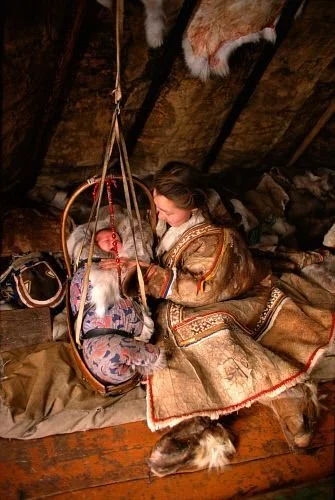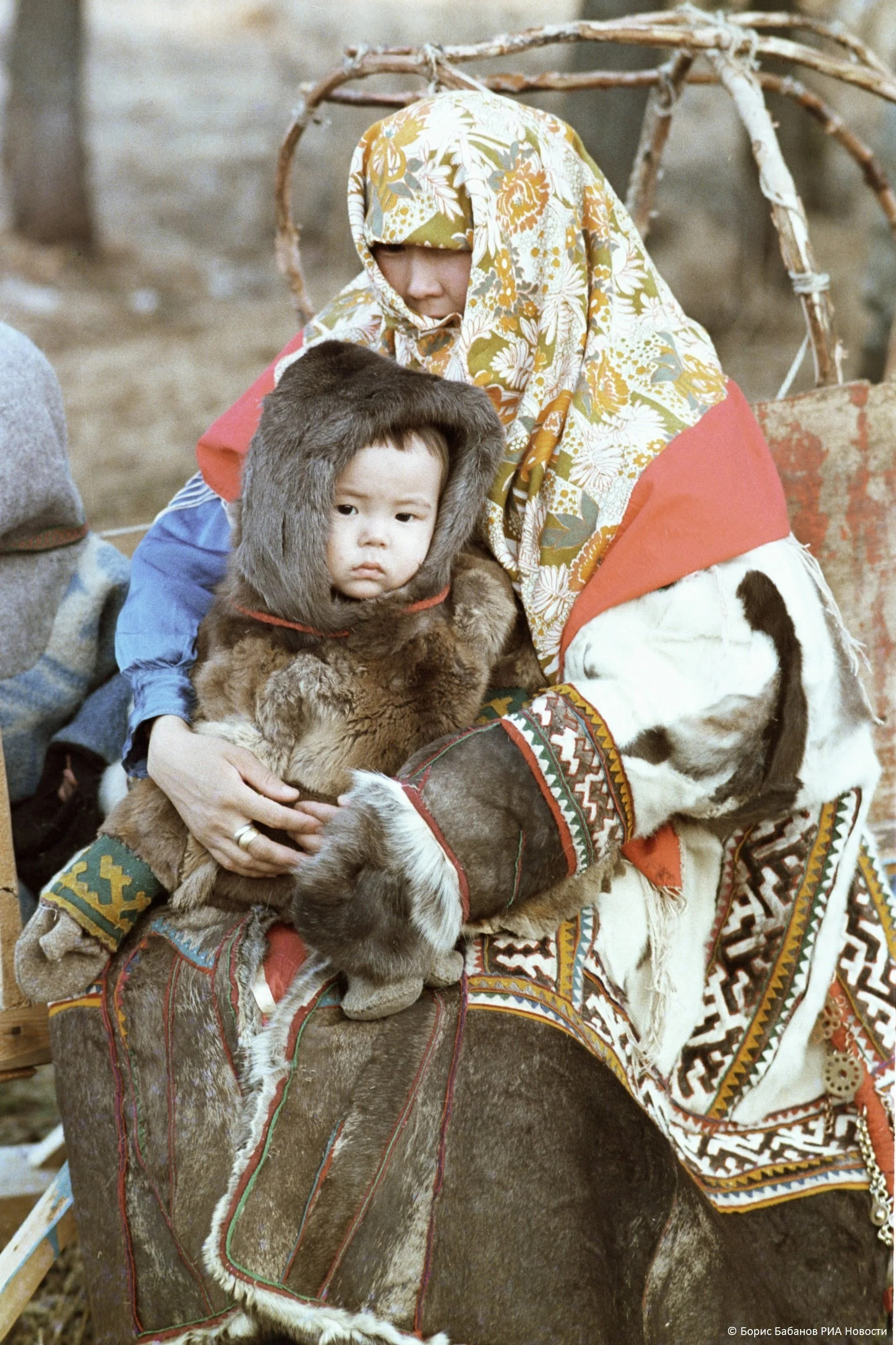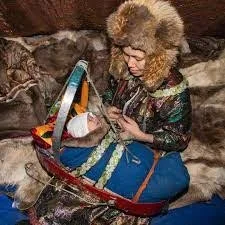Siberia & the Russian Far East: Forest Cradles and Snowbound Journeys
The Indigenous peoples of Siberia and the Russian Far East live across some of the most remote and climatically challenging environments on Earth — from the taiga and tundra to mountainous river valleys and coastal regions. This vast and culturally rich region is home to dozens of unique ethnic groups including the Udege, Evenki, Nanai, Chukchi, Nivkh, Koryak, and Yukaghir peoples, among many others. Each group has developed its own ways of carrying children that reflect their connection to land, mobility, and materials at hand.
In this striking contemporary portrait, an Udege woman wears traditional dress richly embroidered in red, gold, and forest green, her tall headdress edged with protective motifs. Her baby rests securely in a wooden cradleboard, swaddled and fastened with cloth bindings. The Udege are an Indigenous people of the Russian Far East, traditionally living in the forests along the Amur and Ussuri rivers. Cradleboards like this one were used across northern Asia to provide warmth, structure, and safety — allowing babies to be carried, propped upright, or laid down while parents worked. The photograph by Alexander Khimushin forms part of his World In Faces project, honouring Indigenous identity and heritage.
Inside a reindeer-hide tent on the Arctic tundra, a Nenets mother watches over her baby nestled in a suspended cradle, gently wrapped in furs and tradition. The wooden frame sways softly above the warm floor of skins, cradling the child in comfort and safety. Dressed in reindeer hide adorned with delicate trim, the mother’s every gesture speaks of care born from generations of knowledge — where warmth is crafted, closeness is constant, and even in the coldest places on Earth, love is never far from reach.
Bundled in richly embroidered reindeer-hide clothing, a mother from the Evenki people of Siberia cradles her child in the layered warmth of tradition. The baby, nestled securely in fur-lined garments, is protected from the biting cold by careful wrapping and maternal closeness. Both wear garments stitched with geometric motifs passed down through generations, honouring ancestral knowledge and artistry. The mother’s patterned headscarf and layered robe frame her calm presence, while the child’s wide eyes peer out from a snug hood, taking in the world from a place of safety. This is babywearing shaped by the forest and tundra — resilient, beautiful, and deeply rooted in place.
This image shows a beautiful portrait of an Evenki mother with her baby nestled safely in a traditional cradle.
The Evenki are an Indigenous Siberian people, known for their deep connection to reindeer herding, hunting, and forest life. Here, the mother wears a richly decorated outfit with beadwork and fur, reflecting both protection and cultural pride. The baby is cradled warmly in fur within a wooden cradle — a practice that supports comfort, security, and mobility in the harsh Arctic environment.
This tender photograph honours the enduring strength and care embedded in Evenki parenting traditions and beautifully showcases the artistry and resilience of Indigenous Siberian communities today.
Wrapped in warmth and tradition, a mother from Siberia’s far north tends to her baby nestled in a beautifully crafted wooden cradle, lined with soft furs against the Arctic chill. The baby is snugly swaddled and secured beneath a protective arch — a thoughtful design born of generations living in harmony with one of the world’s harshest climates. Clothed in reindeer hide and richly adorned garments, this mother’s quiet moment of care reflects the deep knowledge, resilience, and love woven through the everyday rhythms of Indigenous Arctic life.
Wrapped closely in layers of soft cloth, a baby peeks out from behind their mother’s shoulder, nestled safely in a traditional Inuit-style carrier. The baby’s hood is edged with beaded adornment, offering both warmth and decoration, while the mother turns with a gentle gaze, her face painted with lines of connection and care. The fabric enfolds them both, sheltering the child from Arctic winds and holding them in the heart of family life. Every stitch and curve of the carrier reflects the knowledge of generations who have carried their little ones through snow, silence, and community.
Carriers from this region include rigid wooden cradles for infants, carefully tied with cloth and reindeer sinew, as well as soft pouches worn under fur robes. These were often lined with moss for warmth and absorbency. Some groups used cradleboards with protective canopies or mosquito netting. Others wrapped babies snugly against the body in multiple layers of fur and textile — sometimes within a mother’s coat or a wrap-style garment — providing insulation during long treks or hunting journeys.
Intergenerational caregiving is the norm, with babies frequently carried by grandmothers, older siblings, or extended family. Decorative embroidery and symbolism adorn many cradles and garments, with motifs representing protection, health, and ancestral spirits. In some regions, cradles are lashed to sleds or hung within tents, while in others, carriers are worn on the back or hip in ways that allow the wearer to remain hands-free through the tasks of nomadic or subsistence life.
Today, many of these traditional practices survive in revitalized forms — both through cultural pride and the work of photographers, museums, and Indigenous artists committed to preserving their heritage. Babywearing here is not only functional but deeply woven into language, ceremony, and family life.
A note of gratitude and respect
We respectfully acknowledge and honor the individuals and communities depicted in historical images throughout this series. Many of these photographs were taken in times and contexts where informed consent as we understand it today was not sought or given, and some may have been created through coercion or exploitation.
We share these images with the deepest gratitude, not to romanticize or objectify, but to recognize and celebrate the strength, resilience, and wisdom of these cultural practices. We hold these ancestors and knowledge holders in our hearts and aim to represent their traditions with integrity, humility, and care.
We commit to continuing to learn, listen, and uplift the voices of contemporary community members and descendants, and we welcome guidance on the respectful sharing of these images.






